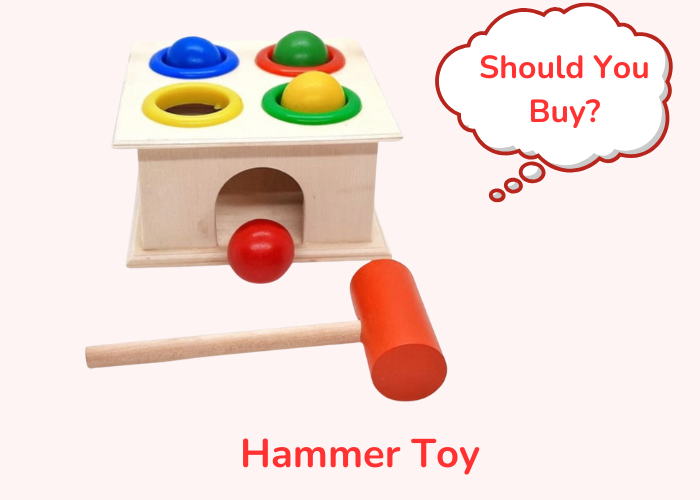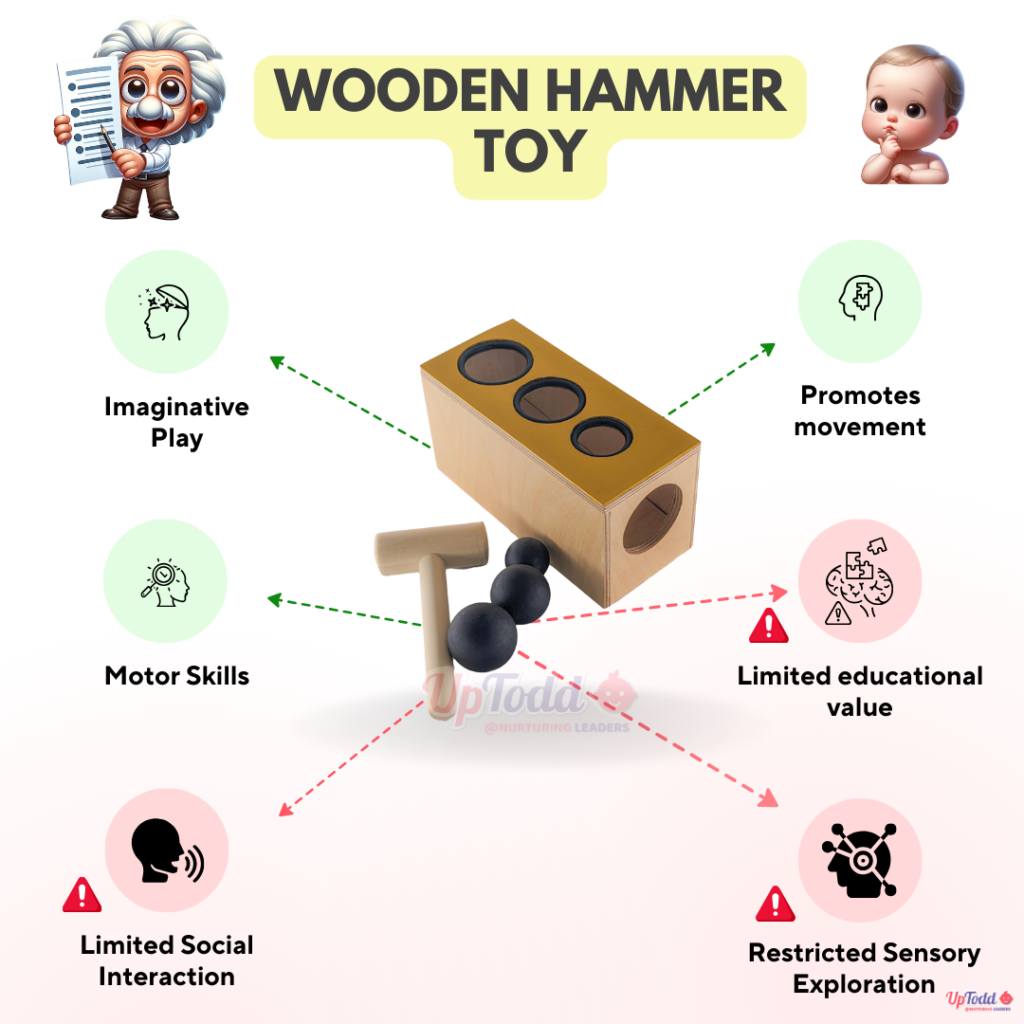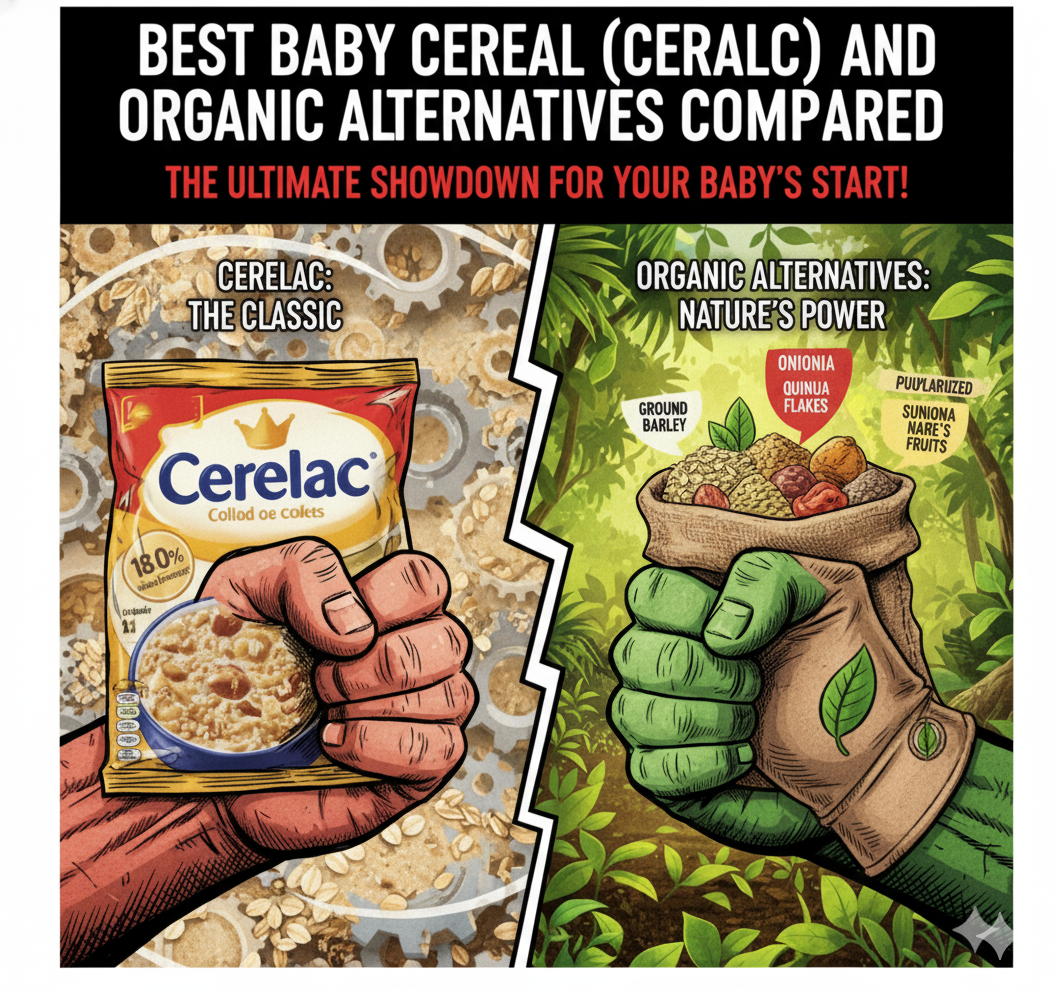
Hammer toy: Pros and Cons
Topic
Hammer toy: Pros and Cons
May start as early as
6 Months
─────────
Related Skills
Introduction: Hammer Toy
There’s something timeless about the sound of a child tapping away with a tiny hammer. The Hammer Toy, often made from wood and featuring colorful pegs, has been a favorite across generations. It’s simple, sturdy, and endlessly engaging a perfect blend of entertainment and skill development.
In a world where most toys flash, sing, or talk, this one stands out for its back-to-basics charm. It doesn’t need batteries or screens just a child’s curiosity and energy. But does it really help in your child’s growth? What are its hidden advantages and possible downsides?
In this blog, UpTodd’s experts take a deep dive into the Hammer Toy’s role in early development, exploring both its strengths and its limitations so you can decide whether it deserves a place in your baby’s play corner.
What We Will Cover in This Blog
- What makes the Hammer Toy unique and timeless
- Developmental benefits of playing with hammer toys
- Possible drawbacks and safety considerations
- Recommended age and materials for safe play
- Expert advice from child specialists
- Conclusion
- Common FAQs from parents about baby and hammer toys

What Makes the Hammer Toy Special
The Hammer Toy is often one of the first playthings that lets a child take action and see a reaction. Every hit produces a satisfying sound and visual reward the peg moves down, the colors shift, and the child feels in control.
This simple yet stimulating feedback loop keeps toddlers engaged and gives them an early sense of achievement. Parents appreciate that it’s screen-free, durable, and safe, while toddlers love the rhythm, color, and repetition.
Beyond its entertainment value, it nurtures essential developmental areas from hand-eye coordination to muscle control while also supporting focus and patience.
Pros of Hammer Toy
1. Develops Fine and Gross Motor Skills
The act of holding the hammer, aligning it with a peg, and striking it requires precision, control, and timing. This repetitive motion strengthens the tiny muscles in a child’s hands, wrists, and arms.
At the same time, larger body movements like swinging the arm or stabilizing the torso improve gross motor coordination. Over time, these motions help in tasks like drawing, writing, buttoning clothes, and even self-feeding.
2. Enhances Hand-Eye Coordination
Hammer toys are one of the best tools for teaching hand-eye coordination. Each strike requires the child to judge distance, aim correctly, and adjust the force. This visual-motor link improves gradually, helping toddlers perform daily activities with accuracy.
It’s a real-life exercise in focus, patience, and control skills that later translate into academic readiness and sports confidence.
3. Encourages Cause and Effect Learning
Every time your child hits a peg and sees it move, they’re learning a fundamental principle of cause and effect “When I do this, something happens.”
This early understanding is at the heart of logical reasoning and problem-solving. Over time, children learn to anticipate outcomes and modify their actions the first step toward analytical thinking.
4. Promotes Independent Play
Unlike interactive or battery-operated toys that often lead play, hammer toys encourage children to take the lead. They decide which peg to hit, how hard, and for how long.
This autonomy helps build confidence, focus, and decision-making. It’s also one of the best ways to support concentration and flow toddlers can spend long stretches fully engaged in hammering.
5. Sparks Creativity and Imagination
While the hammer toy seems straightforward, its open-ended nature inspires creativity. Children often turn it into a pretend game imagining they’re builders, drummers, or inventors.
Through such role play, they develop language, storytelling, and emotional expression, blending physical play with imaginative thinking.
6. Boosts Sensory Development
Wooden hammer toys provide rich tactile feedback the texture of the wood, the sound of the tap, and the movement of the pegs all engage multiple senses.
Wooden hammer toys provide rich tactile feedback — the texture of the wood, the sound of the tap, and the movement of the pegs all engage multiple senses.
Cons of the Hammer Toy
1. Limited Educational Variety
While it supports motor development, the hammer toy doesn’t necessarily challenge a child’s problem solving or creativity after a certain point. Once they’ve mastered the motion, the activity can become repetitive.
To balance this, parents can rotate toys weekly or pair it with sorting or stacking toys to maintain engagement.
2. Risk of Over Enthusiastic Play
Some toddlers may become overly energetic with the hammer. Striking too hard or attempting to hit other objects can pose safety concerns. It’s important to teach controlled movements and ensure gentle, supervised play especially for younger babies under 18 months.
3. Noise Factor
Let’s admit it hammer toys can get noisy. The rhythmic pounding might sound like music to your child but not always to everyone else. To minimize disturbance, opt for rubber tipped hammers or place a soft mat under the toy to muffle sound.
4. Limited Social Interaction
While this toy is excellent for solo play, it doesn’t inherently promote group play or sharing. To encourage social interaction, you can invite siblings or friends to take turns, transforming it into a cooperative game that builds patience and teamwork.
5. Restricted Sensory Range
Compared to toys that light up or make sounds, hammer toys offer a more muted sensory experience. For children who crave strong auditory or visual feedback, you can combine hammer play with musical or color matching toys for added stimulation.
Age Recommendations and Materials
Recommended for children aged 18 months to 24 months, the Wooden Hammer Toy is typically crafted from durable and sustainable materials such as wood. Caregivers should supervise play to ensure safety and guide children through learning opportunities.
The Wooden Hammer Toy is best suited for children aged 6 to 24 months, depending on the design and difficulty level.
- 6–12 months: Start with lightweight, soft-pegged versions to promote gentle tapping.
- 12–24 months: Move to sturdier wooden models to build strength and coordination.
Always check for smooth edges, non-toxic paints, and strong joints. Supervise play closely to avoid misuse or choking hazards.
For eco-conscious parents, opt for sustainably sourced wood it’s safer, biodegradable, and environmentally friendly.
You can also explore our detailed comparison: Why Wooden Toys Must Be Your Baby’s Toys
Expert View: Dr. Nita, Child Development Specialist (UpTodd)
“The Hammer Toy remains one of the most effective tools for early development. It combines physical activity with coordination training and helps build essential focus and persistence. However, the true value lies in how it’s used. Parents should treat it as part of a broader play routine balanced with imaginative, sensory, and social activities. This helps a child develop a well-rounded set of early skills.”
How to Introduce the Hammer Toy at Home
- Start Slowly: Let your baby explore the hammer and pegs before demonstrating how to use them.
- Model Gentle Use: Show tapping rather than hitting. Babies learn best by imitation.
- Add Challenges: As your toddler grows, encourage color matching or timed play to increase focus.
- Mix with Other Activities: Combine hammer play with stacking or sorting toys for variety.
- Praise Effort: Celebrate small achievements to build motivation and confidence.
Conclusion
The Hammer Toy is a simple yet powerful addition to your child’s early play environment. It promotes motor skills, coordination, and focus while sparking curiosity through hands-on action.
Though it may not be as flashy as modern electronic toys, its quiet strength lies in teaching patience, control, and achievement one tap at a time.
Like all toys, it works best as part of a balanced play routine that includes imaginative play, problem-solving activities, and social interactions.
In a digital age full of screens, this humble wooden toy reminds us that sometimes, the simplest things bring the deepest growth.
FAQs
1. How can I make baby toys at home?
You can create safe DIY toys using household materials such as cardboard tubes, fabric scraps, or recycled plastic bottles filled with rice. Ensure they’re securely closed and smooth edged.
2. How can I clean baby toys that cannot be washed?
Wipe the surface using a soft cloth dipped in baby-safe soap water or a vinegar-water mix. For wooden toys, dry immediately after cleaning.
3. How can I disinfect baby toys?
Mix one part vinegar with one part water or use gentle baby-grade sanitizing wipes. Avoid strong chemicals or bleach.
4. How can I clean baby toys with batteries?
Remove batteries first, then clean the outer surface with a slightly damp cloth. Avoid moisture entering electronic parts.
5. How can I store baby toys?
Store toys in labeled bins or baskets by type (wooden, fabric, plastic). This helps maintain order and teaches children early organization habits.
6. Where can I buy safe baby toys?
Purchase from certified toy brands with clear age recommendations, safety markings, and non-toxic certifications.
7. Can I wash soft baby toys in a machine?
Yes, use a gentle cycle with mild detergent. Air-dry completely before giving them back to your baby.
Explore UpTodd to unleash the hidden abilities of the baby.
Explore More
- Baby Toys: Best Picks (Master Cluster)
- Why Wooden Toys Must Be Your Baby’s Toys
- Newborn Toys Suggested by Experts
- Montessori Toys – How to Choose Them for Your Toddler
- Hammer Ball Toy – Pros and Cons






